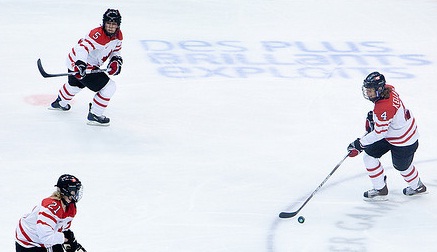
What is the most dangerous sport? Football, boxing, wrestling, cheerleading? None of those, according to a recent survey it's women's ice hockey.
Research from the University of North Carolina has found that female hockey players get concussions at a higher rate than athletes in any other sport, including NCAA football players. These results were reported at the Mayo Clinic, which is holding a conference on concussions in hockey that has also produced the long overdue suggestion that the NHL ban headshots completely.
The raw data is disturbing. The concussion rate in N.C.A.A. women’s ice hockey is 2.72 per 1,000 player hours. For men’s ice hockey it’s 1.47 per 1,000. Even for N.C.A.A. football, the rate is 2.34 per 1,000 — lower than it is for the women on the ice.
Concussions comprised about 25 percent of the injuries in women’s ice hockey, the highest cause of injury in the sport. In men’s ice hockey concussions account for 9 percent of the injuries (No. 2 in the sport), and in football they account for 7 percent (No. 3 in the sport).
How does this happen? It could be because women don't have enough experience playing ice hockey to anticipate the hit coming their way. Other studies in men’s and boys’ hockey show that the greatest risk of concussion occurs in unanticipated hits — and in women’s hockey players may never anticipate a hit.
Doug Stacey, the chief physiotherapist for of Canada’s national women’s teams, including the 2010 gold medal-winning Olympic team, also theorizes that neck strength is the main determinant why women’s concussion rates are so much higher. (Women, he pointed out, have 43 percent less head/neck mass.)
Other theories say since women are new to contact sports they may not be able to identify or report head injuries. I don't know about this theory. With all the news about concussions recently, I think women are just as likey to report them as men.
He cited the concussion stats for the Canadian women’s team in 2009-10: nine concussions among eight different players. In three, the symptoms lasted longer than 21 days.
In general, Stacey pointed out, women experience greater symptoms from concussions; greater cognitive impairments; and have greater mortality and morbidity rates associated with brain trauma.
Looks like concussions will remain a top story in the news, and now women are part of it.
 Thursday, December 4, 2014 at 1:25PM
Thursday, December 4, 2014 at 1:25PM 
 NetcastStudio,
NetcastStudio,  Tech of Sports,
Tech of Sports,  concussions,
concussions,  i1 Biometrics in
i1 Biometrics in  Education,
Education,  Football,
Football,  Gadgets,
Gadgets,  Sports
Sports 

